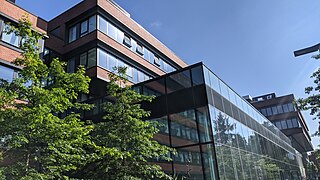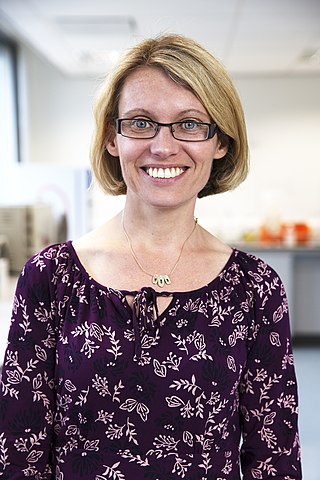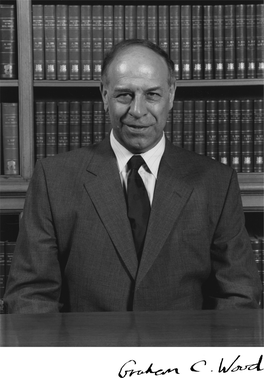
The University of Manchester Institute of Science and Technology (UMIST) was a university based in the centre of the city of Manchester in England. It specialised in technical and scientific subjects and was a major centre for research. On 1 October 2004, it amalgamated with the Victoria University of Manchester to produce a new entity called the University of Manchester.

Manchester Metropolitan University (MMU) is located in the centre of Manchester, England. The university has over 40,000 students and over 4,000 members of staff. It is home to four faculties and is one of the largest universities in the UK, measured by the size of its student population in 2020/21.

The University of Manchester is a public research university in Manchester, England. The main campus is south of Manchester City Centre on Oxford Road. The university owns and operates major cultural assets such as the Manchester Museum, The Whitworth art gallery, the John Rylands Library, the Tabley House Collection and the Jodrell Bank Observatory – a UNESCO World Heritage Site. The University of Manchester is considered a red brick university, a product of the civic university movement of the late 19th century. The current University of Manchester was formed in 2004 following the merger of the University of Manchester Institute of Science and Technology (UMIST) and the Victoria University of Manchester. This followed a century of the two institutions working closely with one another.

Sheffield Hallam University (SHU) is a public research university in Sheffield, South Yorkshire, England. The university is based on two sites; the City Campus is located in the city centre near Sheffield railway station, while the Collegiate Crescent Campus is about two miles away in the Broomhall Estate off Ecclesall Road in south-west Sheffield. A third campus at Brent Cross Town in the London Borough of Barnet is expected to open for the 2025-26 academic year.

The Department of Computer Science at the University of Manchester is the longest established department of Computer Science in the United Kingdom and one of the largest. It is located in the Kilburn Building on the Oxford Road and currently has over 800 students taking a wide range of undergraduate and postgraduate courses and 60 full-time academic staff.

The Department of Materials at the University of Oxford, England was founded in the 1950s as the Department of Metallurgy, by William Hume-Rothery, who was a reader in Oxford's Department of Inorganic Chemistry. It is part of the university's Mathematical, Physical and Life Sciences Division

The Department of Mathematics at the University of Manchester is one of the largest unified mathematics departments in the United Kingdom, with over 90 academic staff and an undergraduate intake of roughly 400 students per year and approximately 200 postgraduate students in total. The School of Mathematics was formed in 2004 by the merger of the mathematics departments of University of Manchester Institute of Science and Technology (UMIST) and the Victoria University of Manchester (VUM). In July 2007 the department moved into a purpose-designed building─the first three floors of the Alan Turing Building─on Upper Brook Street. In a Faculty restructure in 2019 the School of Mathematics reverted to the Department of Mathematics. It is one of five Departments that make up the School of Natural Sciences, which together with the School of Engineering now constitutes the Faculty of Science and Engineering at Manchester.
The School of Chemistry is a school of the University of Edinburgh, in Scotland. In the 2008 Research Assessment Exercise (RAE) the school was ranked sixth in the UK.

Manchester Institute of Innovation Research (MIoIR) is a research institute based in Alliance Manchester Business School at the University of Manchester, UK. MIoIR is a centre of excellence in the fields of innovation studies, technology management and innovation management, science policy, technology policy, innovation policy and regional innovation, the study of emerging technologies, responsible research and innovation, and research into socio-technical transitions with a focus on sustainability and digital transitions. MIoIR has also been known for research on service innovation and in particular the definition and early exploration of the concept of knowledge-intensive business services, through the work of scholars such as Ian Miles and Bruce Tether.
The Faculty of Science and Engineering (FSE) is one of the three faculties that comprise the University of Manchester in northern England. Established in October 2004, the faculty was originally called the Faculty of Engineering and Physical Sciences. It was renamed in 2016, following the abolition of the Faculty of Life Science and the incorporation of some aspects of life sciences into the departments of Chemistry and Earth and Environmental Sciences. It is organised into 2 schools and 9 departments: Chemical Engineering and Analytical Science; Chemistry; Computer Science; Earth and Environmental Sciences; Physics and Astronomy; Electrical & Electronic Engineering; Materials; Mathematics; and Mechanical, Aerospace and Civil Engineering.
The Department of Mechanical, Aerospace & Civil Engineering at the University of Manchester was formed from three departments in the 2004 merger between the Victoria University of Manchester (VUM) and the University of Manchester Institute of Science and Technology (UMIST). The merged departments were the Department of Civil and Construction Engineering which was joint between both universities, the Department of Mechanical Aerospace and Manufacturing Engineering at UMIST and the Manchester School of Engineering at VUM.

The Sackville Street Building is a building on Sackville Street in Manchester, England. The University of Manchester occupies the building which, before the merger with UMIST in 2004, was UMIST's "Main Building". Construction of the building for the Manchester School of Technology began in 1895 on a site formerly occupied by Sir Joseph Whitworth's engineering works; it was opened in 1902 by the then Prime Minister, Arthur Balfour. The School of Technology became the Manchester Municipal College of Technology in 1918.

Anthony John Ryan is an English polymer chemist and sustainability leader at the University of Sheffield. He was Pro-Vice-Chancellor of the university's Faculty of Science from 2008 until 2016, and is currently Director of the Grantham Centre for Sustainable Futures. He delivered the 2002 Royal Institution Christmas Lectures and has appeared on programmes including the BBC Radio 4 comedy and popular science series The Infinite Monkey Cage. He has collaborated on a range of arts and sciences projects with Professor Helen Storey from the London College of Fashion, University of the Arts London.
The A. A. Griffith Medal and Prize was awarded annually from 1965 to 2021 by the Institute of Materials, Minerals and Mining in commemoration of Alan Arnold Griffith.

The Department of Chemical Engineering, Imperial College London is the centre of teaching and research in chemical and process engineering at Imperial College London, occupying the Aeronautics and Chemical Engineering Extension (ACEX), Bone and Roderic Hill buildings, on the South Kensington campus. Formally inaugurated in 1912, the department has over 40 faculty members, 100 postdoctoral researchers, 200 PhD researchers, 80 taught postgraduates, and 500 undergraduates. The department ranks 7th on QS's 2018 world rankings.

The Department of Materials is responsible for the teaching and research in materials science and engineering at Imperial College London, occupying the Royal School of Mines and Bessemer buildings on the South Kensington campus. It can trace its origins back to the metallurgy department of the Government School of Mines and Science applied to the Arts, founded in 1851.
Allan Matthews (1952) is professor of surface engineering and tribology at the University of Manchester and director of the Digitalised Surfaces Manufacturing Network.

Aline Fiona Miller is a Professor of Biomolecular Engineering at the University of Manchester. She specialises in the characterisation of polymer, biopolymer and peptides, using neutron and x-ray scattering, as well as the development of functionalised nanostructures for regenerative medicine and toxicology testing.

Graham Charles Wood FRS was an English corrosion scientist.

Stephen James Eichhorn FRSC FInstP FIMMM CEng is Professor of Materials Science and Engineering at the University of Bristol.















